The peculiarity of mass industrial production is the use of standard patterns created for several sizes. The advantage of individually sewn clothes is their uniqueness. At the same time, the sizes of body parts are taken into account, which will allow sewing a thing according to the features and wishes of the child. To create a scheme, sewing is carried out by measuring a person - taking measurements.
- Purpose of measurements
- Types of children's figures
- Child's clothing size
- Table of baby measurements for newborns
- Preschool Children Size Chart
- Children's size chart by height
- Chinese kids sizes
- Table of correspondence between Russian, American and European sizes
- The principle of taking measurements from a child
- Sequence of taking measurements from a child's figure
- Chest Height II (Chest Height II)
- Shoulder slope width
- Waist length front second
- Chest circumference
- Hip circumference
- Armhole height at the back
- Back to waist length
Purpose of measurements
The procedure of taking measurements will allow you to construct a pattern as accurately as possible.
Please note! Incorrect measurements lead to an incorrectly constructed diagram, and then to damaged fabric.
Knowing how to take measurements correctly is a basic skill that every seamstress should have. Correctly taken measurements affect the fit of the garment. To do this, you must adhere to strict rules.
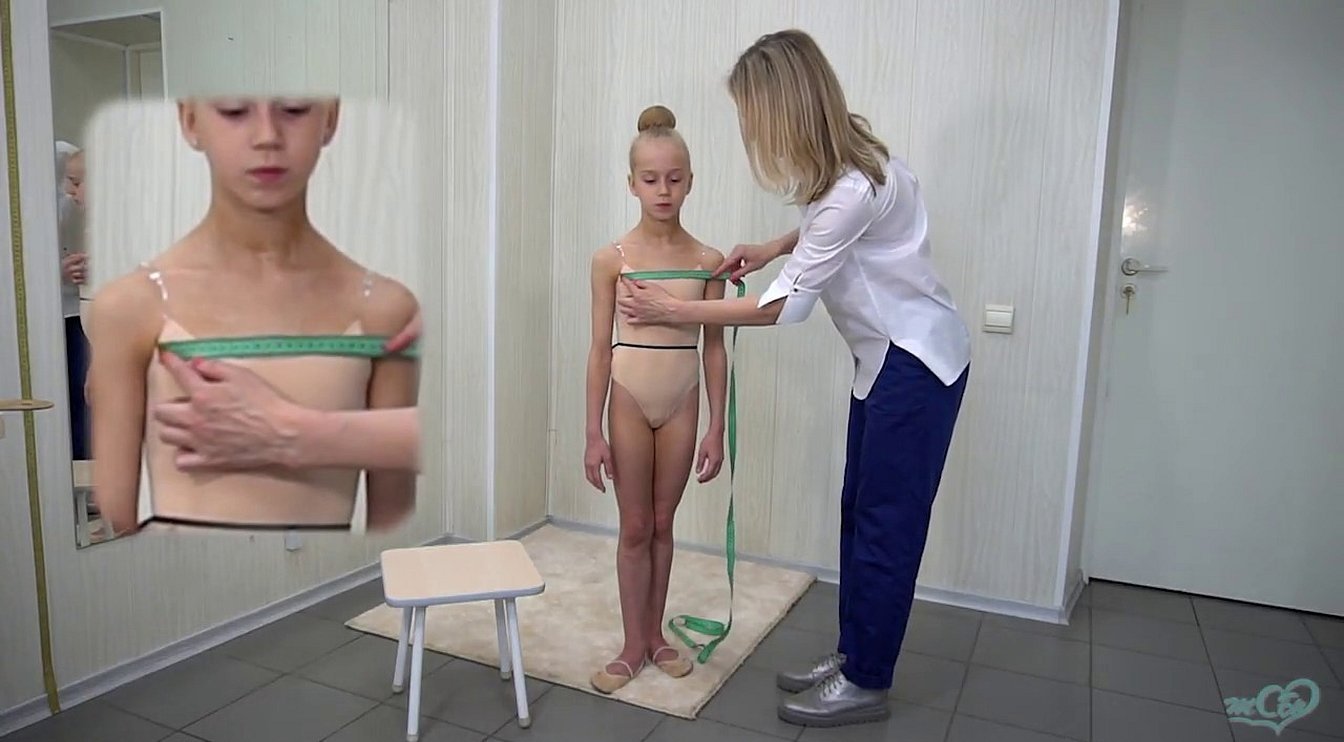
Based on the measurements, a drawing and pattern of the appropriate size is sewn.
The procedure is the first important, responsible step towards constructing a pattern; it eliminates or adds difficulties when trying on, cutting out, and sewing things.
The fit and contour of the garment also depend on the measurements.
It is important to take into account all the features of the body structure.
How to take measurements from a child? Rules that will help a seamstress do this:
- Changing the position will affect the dimensions, so it is recommended to warn the client in advance so that he stands without tension, straight. You can also put the child in front of a full-length mirror. This will help the person see the posture, check the correctness of the structure, length.
- The exact position of the waist has a direct impact on the fit of the garment.
- To take precise measurements, the seamstress uses a pin and a pencil to mark the center of the chest, the direction of the shoulder, the point, and the protruding shoulder blades.
- Free cut allowances are added after taking measurements when constructing the pattern.
- The sizes for the pattern for children are determined by the templates.
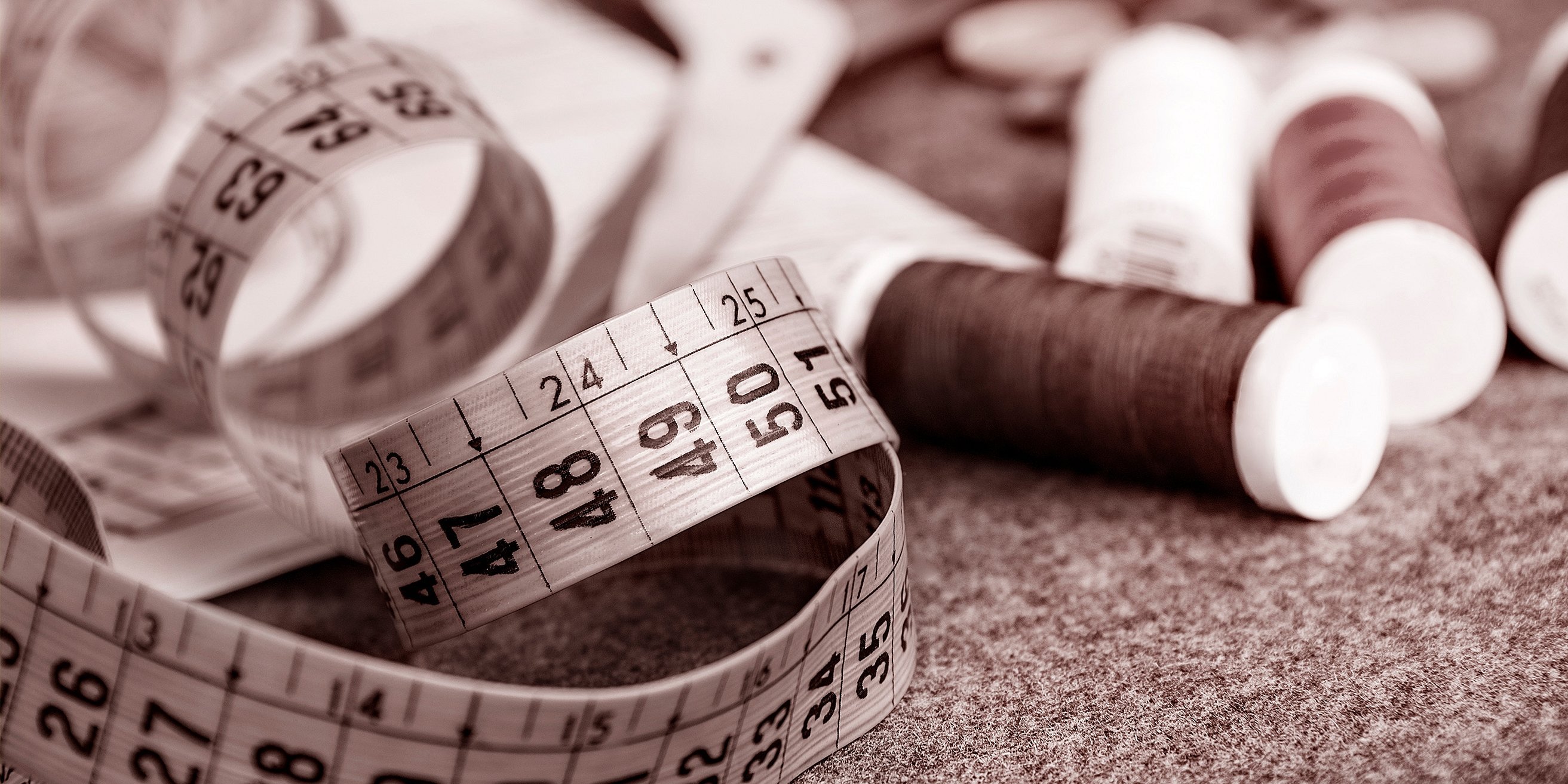
Types of children's figures
Three main characteristics of a child's figure: height, waist, chest. Nursery age - up to 3 years, for sewing, measurements of height, chest in its wide part are used. Children's skirts, trousers use an additional measurement - waist. Starting from preschool age and up to 18 years, the criterion of fullness is used.
Additional information! There are 3 groups by fullness, measured by the difference between the chest and waist circumference. The criterion will help the seamstress to correctly understand the type of product.
Typical figures of boys and girls for constructing patterns according to age:
- nursery age is considered to be from birth to 3 years;
- preschool - from 3 to 6-7 years;
- children of the junior school group 6.5-12 years old;
- secondary school students aged 11.5-15 years;
- teenagers 15-18 years old.
Also in Russia, the child's figure is divided according to the presence of different features:
- Asthenic. The main features are tall stature, narrow shoulders, pelvis, stooped posture, protruding shoulder blades.
- Thoracic. Characteristics - graceful build, straight back, belly, fat deposits, normal muscles, well-developed chest.
- Muscular. Characterized by massive skeleton, broad shoulders and pelvic girdle. At the same time, there is muscle relief, developed musculature.
- Digestive. Conical chest, rounded abdomen, fatty folds are the characteristics of this type.
Important! It is possible that there are no obvious signs that the child belongs to a certain group.
The simplest, ideal result of taking patterns is sewing a suit, a blouse with a hook, a dress with a raglan sleeve. Also, the baby will be especially pleased with a new swimsuit for the summer holiday or a school uniform, which will be unique in the class.

Child's clothing size
Each child develops differently - faster, slower. The measurements of the main dimensions presented in the tables below will help determine the size of the child.
Rules for determining the size:
- The growth of a newborn baby is determined in a lying position, and that of older children only in a standing position.
- For babies, it is important to allow for some room around the belly, as children's clothing should be loose in this area.
- The sleeve length is determined using a measuring tape, from the shoulders to the thumb.
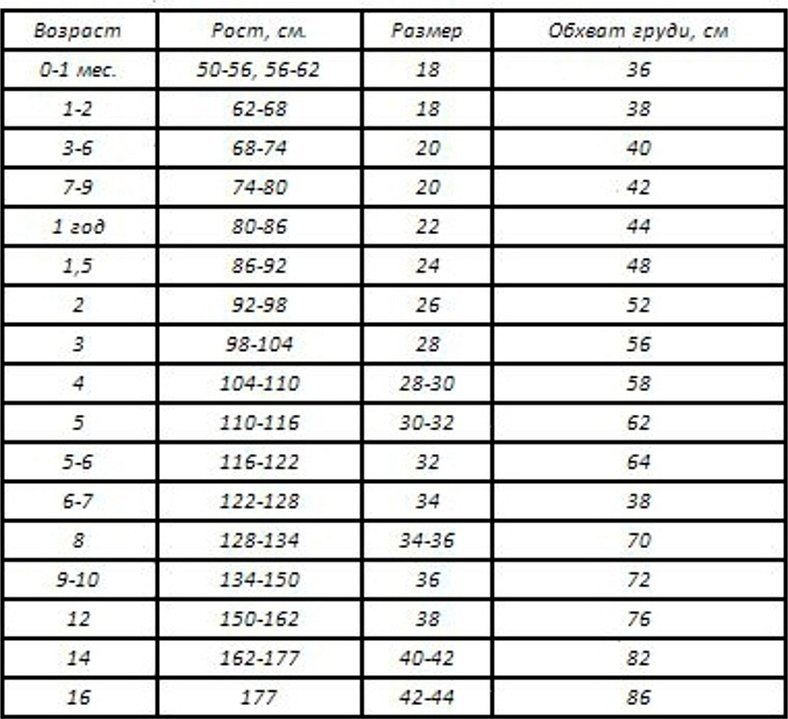
Table of baby measurements for newborns
The table below for determining the size of a newborn is based on the main parameters: height, weight.
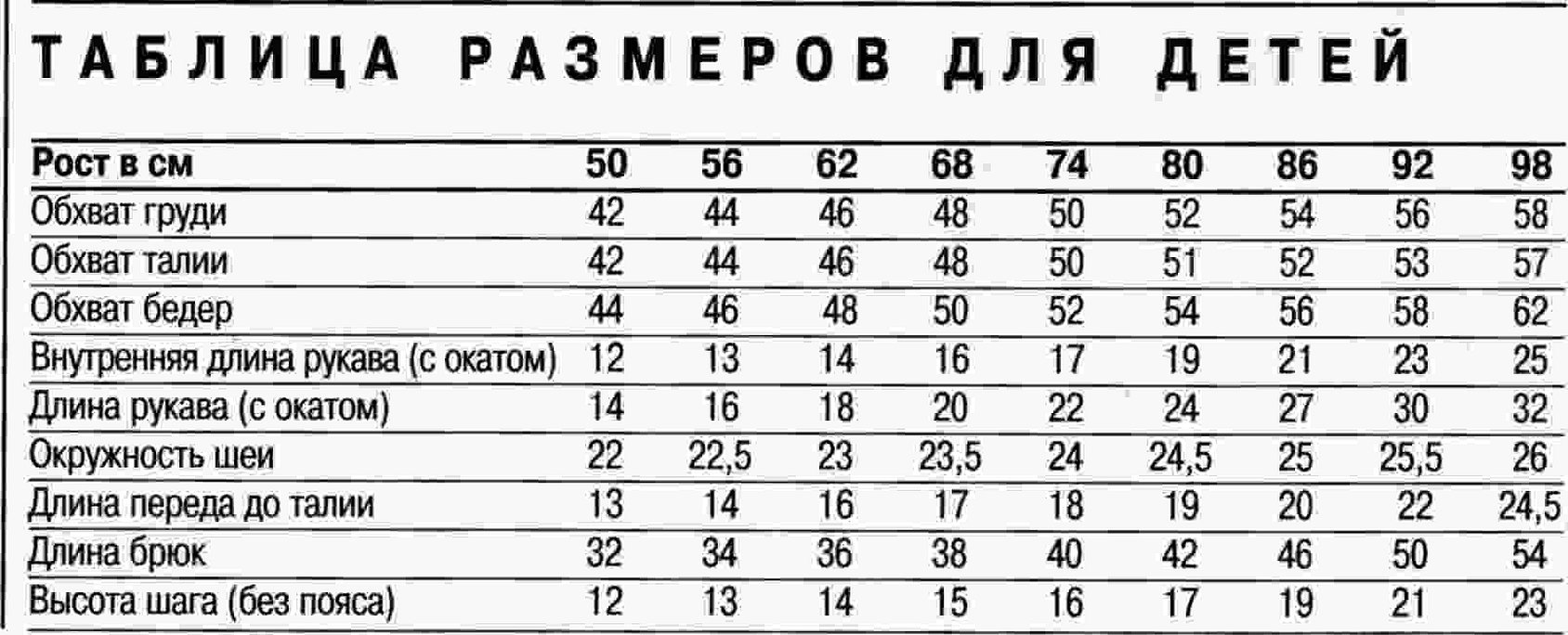
Preschool Children Size Chart
A child at preschool age develops rapidly, therefore, when sewing products, it is recommended to take into account the measurements corresponding to the next age category.
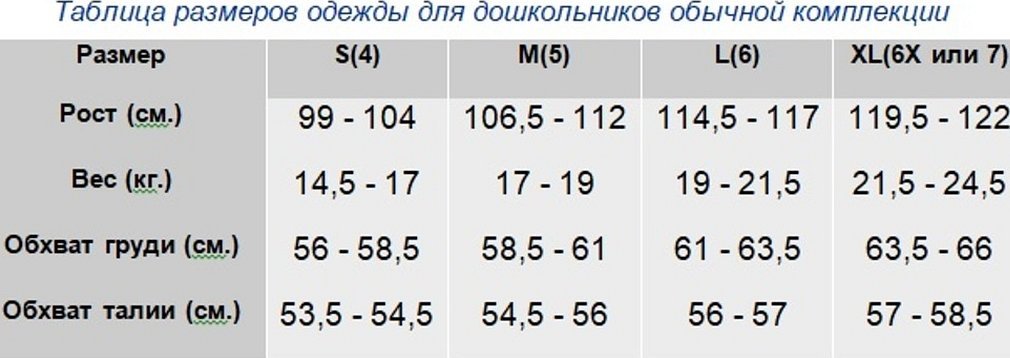
Children's size chart by height
Children's sizes are compiled according to height, age, chest circumference. All sizes are suitable for both sewing and knitting. The tabular presentation of data will help the seamstress to understand in detail the issue of the presence of different criteria for different countries of manufacture.
Chinese kids sizes
In 2019, parents increasingly prefer clothes made in China. The reason for this behavior is the availability of things for a person of any financial status, a variety of assortment, as well as quality that is not inferior to global brands.
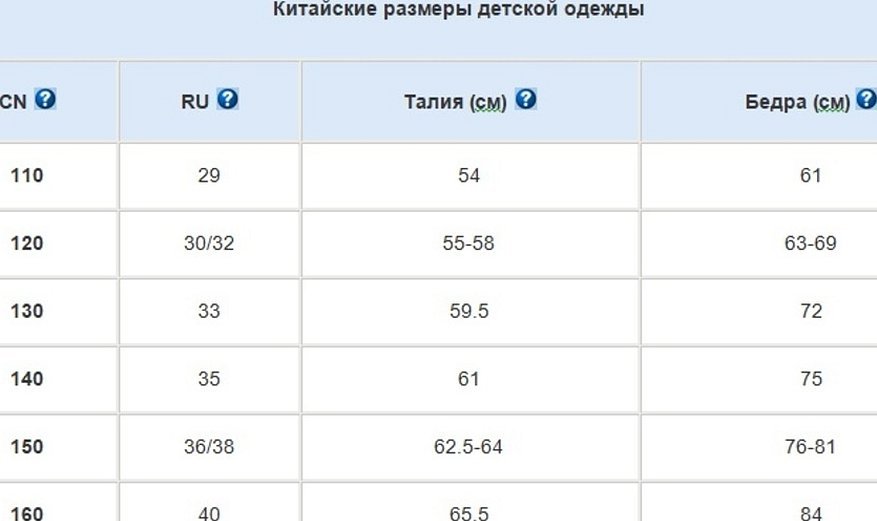
Table of correspondence between Russian, American and European sizes
To coordinate parents in clothing sizes from different countries, the article contains a convenient table with which you can choose a size based on different manufacturers.
| Russia | 28 | 30 | 32 | 34 | 36 | 38 | 40 | 42 |
| USA (US) | 1 | 3 | 5 | 7 | 9 | 11 | 13 | 15 |
| Europe | XXS | XS | S | M | M | L | XL | XXL |
The principle of taking measurements from a child
The length, width, and circumference of children's figures are measured using a measuring tape. When taking measurements of a child under 3 years old, the seamstress does not adhere to specific, strict rules.
During the process, it is recommended to adhere to the following requirements:
- Measure with a thick tape, on which the scale is measured in centimeters. Do not loosen, but pull the tape.
- The model stands up straight, with a normal posture, arms down, heels together, toes turned out.
- It is correct to carry out the procedure without clothes, in nightwear, since extra things distort the readings of the measurements.
- All paired indicators are measured on the right side of the body.
- Possible measurement error is 5 mm.
- First, measurements of the circumference are taken.
- Before measuring, the waist is girded with a cord.
- Length measurements are written down in full, width and girth measurements are written down in half.
Sequence of taking measurements from a child's figure
It is recommended to take measurements according to a certain sequence. Following the step-by-step instructions, the seamstress will take measurements correctly, and also select an individual pattern. The seamstress can measure the client's body using a centimeter. Sewing measurements - the table for girls and boys is identical, complies with GOST, so there are basic requirements according to which the seamstress takes the child's measurements.
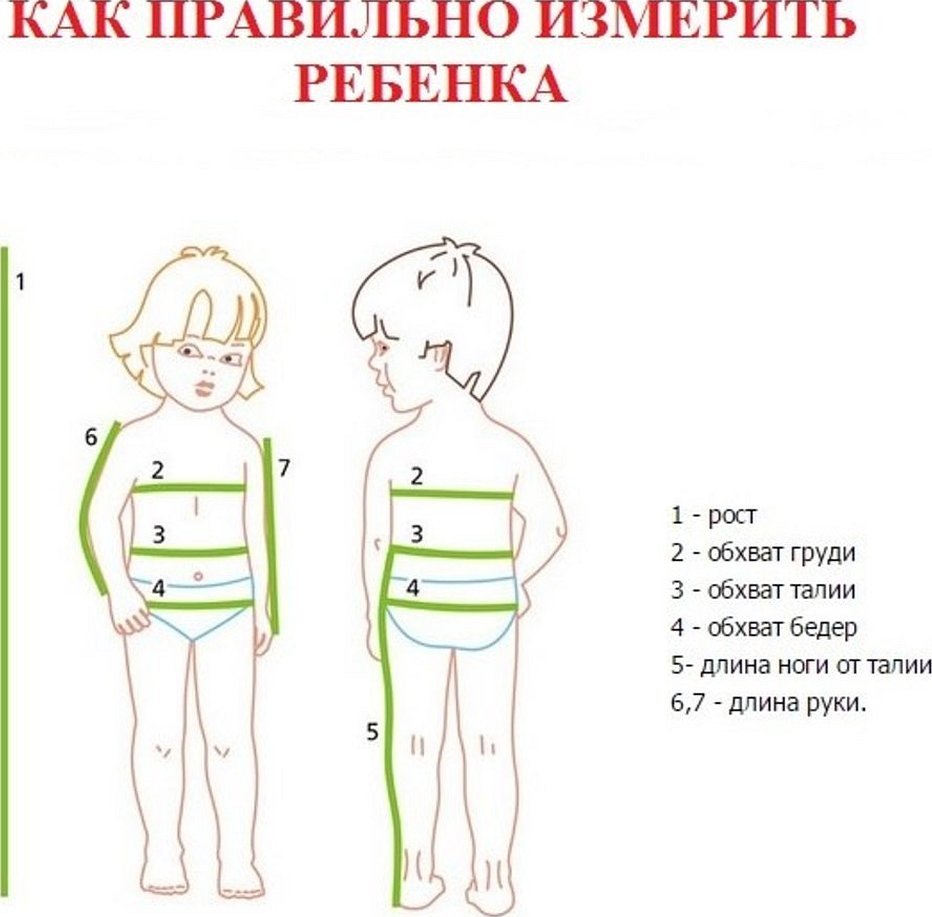
Chest Height II (Chest Height II)
It is recommended to measure chest height in stages:
- Determine the base point of the neck.
- Find the fullest point on your chest.
- Measure the distance between two points.
Shoulder slope width
The generally accepted sequence for the width of the shoulder slope is:
- Determine the base point of the neck.
- Find the point where the arm connects to the shoulder.
- Mark the desired shoulder length.
- Measure the distance from point 1 to point 2.
Please note! If points 2 and 3 do not match, measure the width of the shoulder slope between points 1 and 3.
Waist length front second
It is especially important to strictly follow the instructions for taking waist measurements:
- Determine the base point of the neck.
- Mark a parallel point on the waist.
- Measure the distance from point 1 to point 2 through the most prominent point of the chest.
Chest circumference
The measurement is taken in full and recorded as half the girth.
Technology:
- Determine the point of the armpit.
- It is recommended to start from the back, through the armpit on both sides forward.
- The tape is drawn along the most protruding points of the shoulder blades and chest.
Hip circumference
The measurement is written in units of ½.
Method of removal:
- Determine the most prominent points of the thighs and buttocks.
- Measure the circumference around the body using a tape measure.
- Take into account the protrusion at the front.
Armhole height at the back
Technique:
- Hold the ruler and cardboard cutout under your arm.
- Determine the location of the 7th cervical vertebra.
- Measure the distance from point 2 to the ruler.
Back to waist length
Instructions for taking measurements:
- Place the tape at the back, in the middle of the back.
- Identify the 7th cervical vertebra down to the waist line.
An important stage in designing, sewing is to take measurements correctly. This will allow you to create a high-quality, unique item at a low cost. Anthropological characteristics, human body parameters, and correct determination of the fullness group are useful for custom tailoring.




